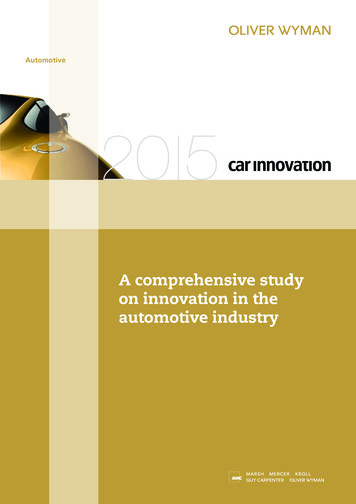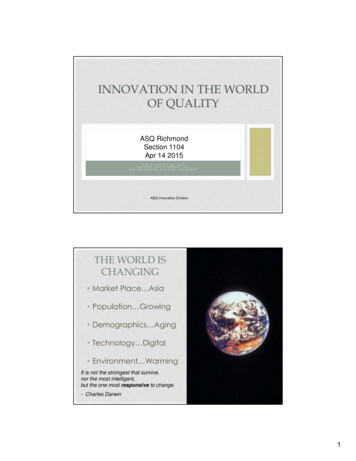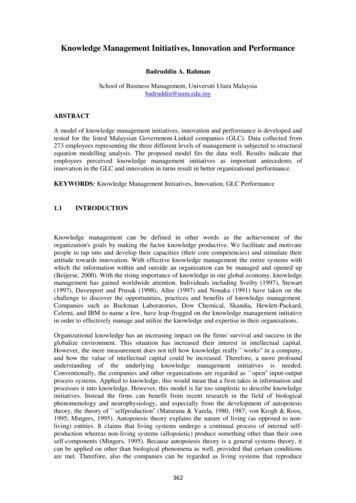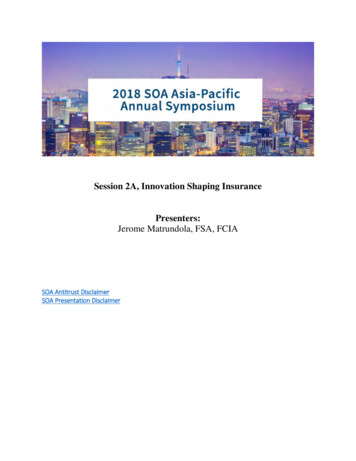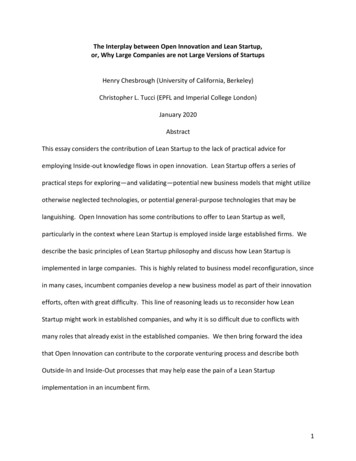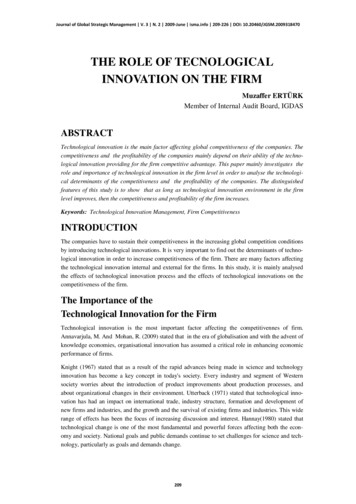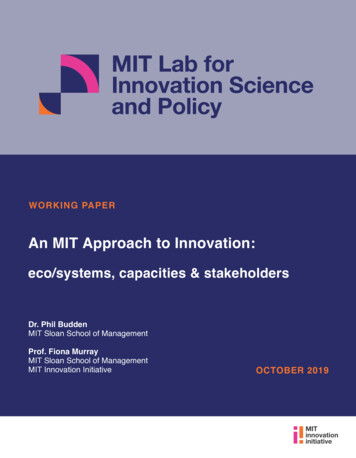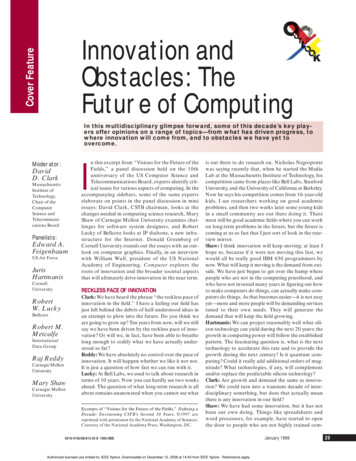
Transcription
.Cover FeatureInnovation andObstacles: TheFuture of ComputingIn this multidisciplinary glimpse forward, some of this decade’s key players offer opinions on a range of topics—from what has driven progress, towhere innovation will come from, and to obstacles we have yet toovercome.JurisHartmanisn this excerpt from “Visions for the Future of theFields,” a panel discussion held on the 10thanniversary of the US Computer Science andTelecommunications Board, experts identify critical issues for various aspects of computing. In theaccompanying sidebars, some of the same expertselaborate on points in the panel discussion in miniessays: David Clark, CSTB chairman, looks at thechanges needed in computing science research, MaryShaw of Carnegie Mellon University examines challenges for software system designers, and RobertLucky of Bellcore looks at IP dialtone, a new infrastructure for the Internet. Donald Greenberg ofCornell University rounds out the essays with an outlook on computer graphics. Finally, in an interviewwith William Wulf, president of the US NationalAcademy of Engineering, Computer explores theroots of innovation and the broader societal aspectsthat will ultimately drive innovation in the near term.CornellUniversityRECKLESS PACE OF INNOVATIONIModerator:DavidD. ClarkMassachusettsInstitute ofTechnology,Chair of theComputerScience andTelecommunications BoardPanelists:Edward A.FeigenbaumUS Air ForceRobertW. LuckyBellcoreRobert M.MetcalfeInternationalData GroupRaj ReddyCarnegie MellonUniversityMary ShawCarnegie MellonUniversityClark: We have heard the phrase “the reckless pace ofinnovation in the field.” I have a feeling our field hasjust left behind the debris of half-understood ideas inan attempt to plow into the future. Do you think weare going to grow up? Ten years from now, will we stillsay we have been driven by the reckless pace of innovation? Or will we, in fact, have been able to breathelong enough to codify what we have actually understood so far?Reddy: We have absolutely no control over the pace ofinnovation. It will happen whether we like it nor not.It is just a question of how fast we can run with it.Lucky: At Bell Labs, we used to talk about research interms of 10 years. Now you can hardly see two weeksahead. The question of what long-term research is allabout remains unanswered when you cannot see whatExcerpts of “Visions for the Future of the Fields,” Defining aDecade: Envisioning CSTB’s Second 10 Years, 1997 arereprinted with permission by the National Academy of Sciences.Courtesy of the National Academy Press, Washington, DC.is out there to do research on. Nicholas Negropontewas saying recently that, when he started the MediaLab at the Massachusetts Institute of Technology, hiscompetition came from places like Bell Labs, StanfordUniversity, and the University of California at Berkeley.Now he says his competition comes from 16-year-oldkids. I see researchers working on good academicproblems, and then two weeks later some young kidsin a small community are out there doing it. Theremust still be good academic fields where you can workon long-term problems in the future, but the future iscoming at us so fast that I just sort of look in the rearview mirror.Shaw: I think innovation will keep moving; at least Ihope so, because if it were not moving this fast, wewould all be really good IBM 650 programmers bynow. What will keep it moving is the demand from outside. We have just begun to get over the hump wherepeople who are not in the computing priesthood, andwho have not invested many years in figuring out howto make computers do things, can actually make computers do things. As that becomes easier—it is not easyyet—more and more people will be demanding servicestuned to their own needs. They will generate thedemand that will keep the field growing.Hartmanis: We can project reasonably well what silicon technology can yield during the next 20 years; thegrowth in computing power will follow the establishedpattern. The fascinating question is, what is the nexttechnology to accelerate this rate and to provide thegrowth during the next century? Is it quantum computing? Could it really add additional orders of magnitude? What technologies, if any, will complementand/or replace the predictable silicon technology?Clark: Are growth and demand the same as innovation? We could turn into a transient decade of interdisciplinary something, but does that actually meanthere is any innovation in our field?Shaw: We have had some innovation, but it has notbeen our own doing. Things like spreadsheets andword processors, for example, have started to openthe door to people who are not highly trained com-0018-9162/98/ 10.00 1998 IEEEAuthorized licensed use limited to: IEEE Xplore. Downloaded on December 12, 2008 at 14:43 from IEEE Xplore. Restrictions apply.January 199829
.puting professionals, who have come at the academiccommunity from the outside. I remember whennobody would listen if you wanted to talk about texteditors in an academic setting. Most recently, therehas been the upsurge of the World Wide Web. It is truethat Mosaic was developed in a university, but notexactly in the computer science department. These aregenuine innovations, not just nickel-and-dime things.Feigenbaum: I think the future is best seen not in termsof changing hardware or increased numbers of MIPS(or GIPS), but rather in terms of the software revolution. We are now living in a software-first world. I thinkthe revolution will be in software building that is nowdone painstakingly in a craftlike way by the major companies producing packaged software. They create asuite—a cooperating set of applications—that takes thecoordinated effort of a large team. What we need to donow in computer science and engineering is to invent away for everyone to do this at his or her desktop; weneed to enable people to “glue” packaged softwaretogether so that the packages work as an integratedsystem. This will be a very significant revolution.I think the other revolution will be the one LeonardKleinrock called didactic or intelligent agents. Theagent allows you to express what you want to accomplish, providing the agent with enough knowledgeOutlook onComputerScienceen years from now, we may concludethat this was the coming of age forcomputer science. Certainly, it isgoing through a transition, which likemany transitions, may appear a littlepainful to some living through it.It’s a lot like the fencing of the AmericanWest. Those who worked in the earlydecades of CS had wide-open spaces for original ideas to flourish. That space is now populated with mature innovations, successfulproducts, and large corporations, which I’msure seems confining to some. The currentcontext of CS is shaped by past success andchronic trouble spots.Past success makes blue-sky innovationseem more daunting and risky. It can trapunwary researchers in the present and keepthem from exploring the future. Whatinnovative operating system could haveany impact, given the market presence ofMicrosoft? What novel idea for global networking could displace the Internet? Whatnew paradigm of computing could compete with the PC?At the same time, some of the intellectualproblems CS has struggled with, such asbuilding large and trustworthy systems,seem to have a timeless quality: The complaints about building systems seem thesame as a decade ago. But there has beenprogress—in the last decade networks haveinterconnected the world and made a newT30range of large systems possible. Perhaps thereal issue is that aspirations to build biggerand more complex systems are potentiallyunbounded, kept in check only by the limits of what can actually be built. So systembuilders live in a constant state of frustration, always hitting (and complainingabout) the same limitations, even though thesystems they can now build are indeed bigger and more complex than a decade ago.Past successes change the imperative forfuture research. Whereas the past wasdefined by articulating new objectives (Let’sbuild an Internet), past achievements nowdemand incremental innovation (Let’s addsupport for audio streams to the Internet).That sort of work, while less broad inscope, is critical to the progress of the field.Part of coming of age is learning to equallyrespect innovation and enhancement.The locus of the hard CS problems hasalso shifted. Look at the systems area.Although there’s still room for innovationin traditional areas such as language design(consider Java), more and more of the hardproblems arise when people try to putcomputers to use. This implies that if com-puter scientists are to contribute to important emerging problems, they mustincreasingly act as anthropologists and golive for a time in the land of the application builders. Computer scientists are nowworking on diverse problems: ensuringprivacy, rendering complex images forrealistic games, and understanding humanspeech. The Web is a wonderful exampleof an application that has spawned lots ofinteresting problems, such as the construction of powerful search engines, algorithms for caching and replicating Webpages, the naming of information objectsand secure networks.Of course, parts of CS view their role lessas innovating new artifacts and more asdeveloping the underpinnings of CS as a science. There is much about CS that is not yetunderstood in any rigorous way, and therate of innovation turns up new problemsto understand faster than the old ones canbe solved. For those who build the foundations of the field, there is no immediate fearof running out of problems to work on,even if innovation were to slow down.oes the coming of age mean that theera of big change is over? I think not.In the next 10 years, user interfaces,the PC, the Internet, and even Windowswill have mutated, perhaps almost beyondrecognition. What will actually characterize the next decade is the sometimes turbulent interplay between improving thepast and overthrowing it at the same time.Anyone who thinks the fun is over has justwalked off the field at half time. D— David D. Clark, Chair, Computer Science and Telecommunications BoardComputerAuthorized licensed use limited to: IEEE Xplore. Downloaded on December 12, 2008 at 14:43 from IEEE Xplore. Restrictions apply.
.about your environment and your context for it toreason exactly how to accomplish it.SILICON AND FRUSTRATIONClark: One statement made at the beginning of thisdecade was that the nineties would be the decade ofstandards. There is an old joke: the nice thing aboutstandards is that there are so many to pick from. Intruth, I think that one of the things that has happenedin the nineties is that a few standards happened to winsome sort of battle—and not because they are necessarily the best.Lucky: This is both a tragedy and a great triumph.You can build a better processor than Intel or a better operating system than Microsoft, but it does notmatter. It just does not matter.Clark: How can you hurtle into the future at a reckless pace and simultaneously conclude that it is allover, it does not matter because you cannot do something better, because it is all frozen in standards?Metcalfe: There seems to be reckless innovation onalmost all fronts except two, software engineering andthe telco monopolies.Clark: Yet if we look at the Web, we have a regrettable set of de facto standards in HTML and HTTP,both of which any technologist would love to hate.When you try to innovate by saying it would be better if URLs were different, the answer is, “Yes, wellthere are only 50 million of them outstanding, so goaway.” Therefore, I am not sure I believe your statement that there is rapid innovation everywhere, exceptfor these two areas.Lucky: It is possible that if all the dreams of the Javaadvocates come true, this will permit innovation ontop of a standard. It is one way to get at this problem.We do not know how it is going to work out, but atleast this would be the theory.Clark: I actually believe it might be true. A tremendousengine exists that is really driving the field and that isthe rate of at least performance innovation, if not costreduction, in the silicon industry. I think this enginedrove us forward, but I am not sure it’s the only engine.I wonder if [ten years from now] we will say, “Yes, silicon drove us forward,” or will there be other things?Is the Web a creation of silicon innovation?Shaw: No, it is a creation of frustrated people who didnot feel like dealing with ftp and telnet, but stillwanted to get to information.Clark: I think you just said that silicon and frustration are our drivers.Lucky: Silicon has really made everything possible.This is undeniable, even though we spend most of ourtime, all of us, working on a different level.Clark: I once described setting standards on theInternet as being chased by the four elephants of theapocalypse. The faster I ran, the faster they chased mebecause the only thing between them and making abillion dollars was the fact that we had notworked this thing out. We cannot outrunSomeone once saidthem. If it is a hardware area, we can hallucithe nineties wouldnate something so improbable we just cannotbe the decade ofbuild it today. Then, of course, we cannotbuild it in the lab, either. We used to try tostandards. There ishave hardware that let us live 10 years in thean old joke: The nicefuture. Now I am hard-pressed to get a PC onthing aboutmy desk. Yet in the software area, there reallystandards is thatis no such thing as a long-term answer. If youcan conceive it, somebody can reduce it tothere are so many topractice. So I do not know what it means tochoose from.be long term anymore.Feigenbaum: If you look at what individualfaculty people do, you find smallish things ina world that seems to demand more team and systemactivity. There is not much money around to fund anything more than small things, basically to supplementa university professor’s salary and a graduate studentor two, and perhaps run them through the summer.Partly this is because of a general lack of money. Partlyit is because we have a population explosion problemand all these mouths to feed. All the agencies that werefeeding relatively few mouths 20 years ago are nowfeeding maybe 100 times as many assistant professorsand young researchers, so the amounts of money goingto each are very small. This means that, except for theoccasional brilliant meteor that comes through once ina while, you have relatively small things being done.When they get turned into anything, it is because theindividual faculty member or student convinces anindustry to spend more money on it. Subsequently, theworld thinks it came out of industry.LOOKING OUTWARD AT REAL PROBLEMSAnita Borg (audience member): I wanted to talk a bitabout where you get innovation and where academicsget ideas for problems to work on. This is somethingI talk about every time I go, as an industry person, totalk to a university. If we keep training students tolook inside their heads and become professors, we losethe path of innovation. If we train our students to lookat what industry is doing and what customers andpeople out there using these things cannot do—to notbe terrorized by what they can do, but to look atwhere they are running into walls—our students startappreciating these as the sources of really hard problems. I think this focus is lacking in academia to someextent and looking outward at real problems givesyou focus for research.Hartmanis: I fully agree. Students should be wellaware of what industry is and is not doing, and Ibelieve that many are well informed.Shaw: Earlier I mentioned three innovations that camefrom outside the computer science community: spreadsheets, text formatting, and the Web. I think they cameabout because people outside the community hadJanuary 1998Authorized licensed use limited to: IEEE Xplore. Downloaded on December 12, 2008 at 14:43 from IEEE Xplore. Restrictions apply.31
.Outlook onSoftwareSystem Designver the last decade, computers havebecome nearly ubiquitous, and theirusers are often people who neither have,nor want, nor (should) need, years of specialtraining in computing. Business computersare often in the hands of information users,no longer under exclusive control of a centralized information systems department.Instead of gaining access to computers onlythrough professional intermediaries, vastnumbers of people are responsible for theirown computing—often with little systematictraining or support. This disintermediation—the direct association between users and theirsoftware—has created new problems for software system designers.If all these computers are to be genuinelyuseful, their owners or handlers must be ableto control them effectively: they must understand how to express their problems, theymust be able to set up and adapt the computations, and they must have reasonableassurance of the correctness of their results.This must be true across a wide range ofproblems, spanning business solutions, scientific and engineering calculations, and document and image preparation. Furthermore,owners of personal computers must be ableto carry out the tasks formerly delegated tosystem administrators, such as configuration, upgrade, backup, recovery.The means of disintermediation havebeen available, affordable hardwaretogether with application-targeted software that produces information and computing in a form the end user canunderstand and control. The software carriers—the “killer apps”—have beenspreadsheets, the Web, integrated officesuites, and interactive environments suchas MUDs (multiuser domains). To a lesserdegree, Visual Basic has enabled peoplewith minimal programming experience tocreate useful software that fits their ownneeds. These applications have becomewinners in the marketplace because theyput a genuinely useful capability in thehands of people with real problems.The software system design communityO32should be alarmed to notice that these killerapps have emerged from outside theirresearch world. Worse, the research community has often (at least initially) failed totake these applications seriously. Suchapplications have been regarded as toys, notworthy of serious attention; they have beenfaulted for a lack of generality or (imagined)lack of scalability; they have been ignoredbecause they don’t fit the establishedresearch mold. But software system designresearchers comprise the very communitythat should be breaking the mold and providing solutions for real-world needs.Although it’s always risky to predict themarket, one place to look for ideas is the relation between the people who use computingand the computing they use. We’ve alreadyseen substantial disintermediation, as moreand more people have direct access to theircomputers and software. At present, theircomputing is dominated by individual interactive computations, which lets them monitor results as they go. It is more challengingto set up stand-alone processes that rununmonitored. This requires describing policy for an open-ended set of computations,not just manipulating instances. We can seethe small beginnings of such independentprocesses in mail filters, automatic check payments, and the daemons that select articlesfrom news feeds. But what will be required toenable large numbers of users to set upautonomous software agents with largerresponsibilities? At what point will the public at large trust the Internet and electroniccommerce mechanisms enough to carry outindividual transactions? When will consumers be willing to have an autonomoussoftware agent spend money on their behalf?Another potential change in the relation between people and computing is afusion between computing and entertainment. This will, of course, requireinfrastructure development in bandwidth, 3D display, intellectual propertyprotection, and electronic commerce—the usual stuff of software system designresearch. Beyond that, though, what newcapabilities will the consumer need?What will be required to make entertainment both interactive and multiparty?How can individuals become producersas well as consumers of computer-basedentertainment?What does all this mean for softwaresystem design research? First, we must recognize the important—and difficult—research problems that these applicationscarry, including how to analyze component interoperabilityand develop techniques for copingwith incompatibility; specify and implement event-drivensystems that support the dynamicreconfiguration of loosely confederated processes or agents; support metainformation that carriestype, signature, performance, andother information needed to automate distributed agents; manage families of related systems; deal with the security issues of electronic commerce; design for “gentle-slope systems,” inwhich the learning time required iscommensurate with the application’ssophistication; integrate multiparty real-time interaction with other applications(beyond chat rooms, electronic whiteboards, MUDs, and virtual communities); and analyze requirements for market segments rather than individual bespokesystems.econd, we should contribute todeveloping accurate models of computer use that are simple enough fornonspecialists to understand. Finally, weshould increase interdisciplinary workwith researchers in human-computer interaction and in application areas. — Mary Shaw, Carnegie Mellon UniversitySComputerAuthorized licensed use limited to: IEEE Xplore. Downloaded on December 12, 2008 at 14:43 from IEEE Xplore. Restrictions apply.
.something they needed to do and were not getting anyhelp doing it. So we will get more leads by looking notonly at the problems of computer scientists, but also atthe problems of people who do not have the technicalexpertise to cope with these problems. I do not thinkthe next innovation is going to be an increment alongthe Web, or an increment on spreadsheets, or an increment on something else. What Anita is asking us tothink about is, how are we going to be the originatorsof the next killer application, rather than waiting forsomebody outside to show it to us?Reddy: If you go back 40 years, it was clear that certain things were going to have an impact on society—for example, communications satellites, predicted byArthur Clarke; the invention of the computer; and thediscovery of the DNA structure. At the same time,none of us had any idea of semiconductor memoriesor integrated circuits. We did not conceive of theArpanet. All of these came to have an impact. So myhypothesis is that some things we now know will havean impact. One is digital libraries. The term digitallibrary is a misnomer, the wrong metaphor. It ought tobe called digital archive, bookstore, and library. It provides access to information at some price, includingno price. In fact, the National Science Foundation andDARPA have large projects on digital libraries, butthey are mainly technology-based—creating that technology to access information. Nobody is working onthe other problem of content.We have a Library of Congress with 30 million volumes; globally, the estimate is about 100 million volumes. The US Government Printing Office produces40,000 documents consisting of six million pages thatare out of copyright. Creating a global movement—because it is not going to be done by any one country orany one group—to get all the content (to use Jefferson’sphrase, all the authored works of mankind) online is it.At Carnegie Mellon University, we are doing two thingsto help. In collaboration with National Academy Press,we are beginning to scan, convert, correct, and put inHTML format all its out-of-print books. There arealready about 200 to 300 of them. By the end of theyear, we expect to have all of them. The second thingCMU is doing is offering to put all authored works ofCSTB members on the network.FIXING THE INTERNETMetcalfe: The Internet is one of our big success stories and we should be proud of it, but it is broken andon the verge of collapse. It is suffering numerousbrownouts and outages. Increasingly, the people I talkto, numbering in the high 90 percent range now, aregenerally dissatisfied with its performance and reliability.There is no greater proof of this than the proliferation of intranets. The good reason people build themis to serve internal corporate data processing applica-tions, as they always have. The bad reason theybuild them is that the Internet offers inadequateWe need to fixsecurity, performance, and reliability for itsuses. So we now have a phenomenon in comthe Internet,panies. The universities, as I understand it, arewhich means addingcurrently approaching NSF to build anotherfacilitiesby which itNSFnet for them. This is really a suggestion notcan be managed.to fix the Internet, but to build another networkfor us.These facilities areOf course, the Internet service providers arenot in the Internetalso tempted to build their own copies of thebecauseuniversitiesInternet for special customers and so on. Ifind managementbelieve this is the wrong approach. We need tobe working on fixing the Internet. Lest you beboring and do notin doubt about what this would include, itwork on it.would mean adding facilities to the Internet bywhich it can be managed. I claim that these facilities are not in the Internet because universitiesfind management boring and do not work on it.Fixing the Internet also would include adding mechanisms for finance so that the infrastructure can begrown through normal communication between supply and demand in our open markets, and adding security; it is not the National Security Agency’s fault thatwe do not have security in the Internet. It occurredbecause for years and years working on security hasbeen boring, and no one has been doing it; now wefinally have started.We also need to add money to the Internet—not thefinance part I just talked about, but electronic moneythat will support electronic commerce on the Internet.We need to introduce the concept of zoning in theInternet. The Communications Decency Act is aneffort, although a lame one, to bring this about. Onthe Internet, mechanisms supporting freedom ofspeech have to be matched by mechanisms supportingfreedom not to listen.We need progress on the development of residential networking. The telecommunications monopolieshave been in the way for 30 or 40 years, and we needto break these monopolies and get competition working on our behalf.Shaw: We talked a lot about software and a littleabout the Web, which is really a provider of information rather than of computation at this point. Ibelieve we should not think about these two thingsseparately, but rather about their fusion as information services, including not only computation andinformation, but also the hybrid of active information. On the Web, we have lots of information available as a vast undifferentiated sea of bits. We havesome search engines that find us individual points. Weneed mechanisms that will allow us to serve more systematically and to retain the context of the search. Tofundamentally change the relation between the usersand the computing, we need to find ways to makecomputing genuinely widespread and affordable, priJanuary 1998Authorized licensed use limited to: IEEE Xplore. Downloaded on December 12, 2008 at 14:43 from IEEE Xplore. Restrictions apply.33
.vate and symmetric, and genuinely intellectually accessible by a wider collection of people.I thank Bob Metcalfe for saying most of what I wasgoing to say about what needs to be done because thenetworks must become places to do real business,rather than places to exchange information amongfriends. In addition, we need to spend more timethinking about what you might call naïve models, thatis, ways for people who are specialists in somethingother than computing to understand the computingmedium and what it will do for them, and to do thisin their own terms so they can take personal controlover their computing.Lucky: I know two things about the future. First, afterthe turn of the century, one billion people will be usingthe Internet. Second, I do not have the foggiest ideawhat they are going to be using it for. We have createdsomething much bigger than us, where biological rulesOutlook on Telecommunicationshe familiar telephone network hasserved us well for a century.Yesterday’s grand challenge—connecting the planet with voice telephony—has been accomplished.But as the new century looms, a revolutionary model for telecommunications hasthrust itself on an unsuspecting industry.It is a model based on the Internet, whereall communications take the form of digital packets, routed from node to nodeaccording to IP, or Internet Protocol. Thisis a world in which the Esperanto thatenables intercommunication between disparate networks means expressing everything in IP packets. The future plug onyour wall will speak IP, and the service itoffers will be IP dial tone.Today’s infrastructure is a circuitswitched network in which the dominanttraffic is voice, and the medium of exchange among networks is the standard3-kHz analog channel. To transmit data,we use modems to change the digital signal into a voicelike analog signal compatible with this transmission format. Thenetwork of the future will invert this paradigm—reformatting voice to look likedata. The natural medium of exchange willbe the IP packet.The new IP-dial tone network is happening very fast. It is well known that thenumber of host computers on the Internetdoubles annually, and estimates on theannual growth of data traffic in theInternet backbone start at a factor of 4 andgo up to 10. Thus the traffic is growingfaster than the number of users, indicatingT34that the average user is consuming considerably more bandwidth each year.People speak of two forthcomingevents: The crossover, when data trafficequals voice traffic, will probably happenin the next several years. Soon after, however, we will have the eclipse, when datatraffic becomes an order of magnitudelarger than voice traffic.Moreo
West. Those who worked in the early decades of CS had wide-open spaces for orig-inal ideas to flourish. That space is now pop-ulated with mature innovations, successful products, and large corporations, which I'm sure seems confining to some. The current context of CS is shaped by past success and chronic trouble spots.



